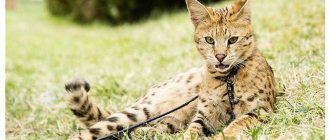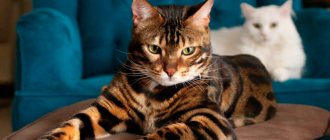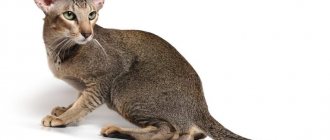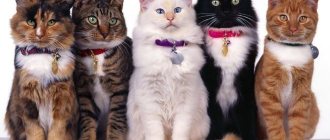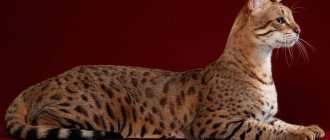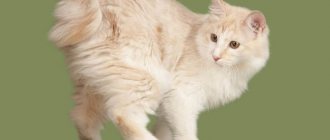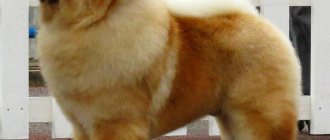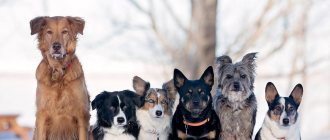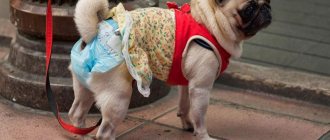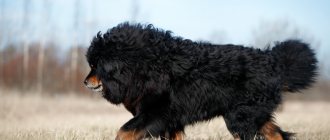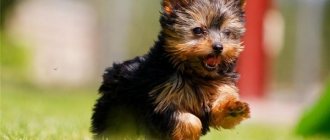All cat lovers have dreamed of petting a tiger at least once. Or a lion. Or a snow leopard. Well, or any other big cat that you just can’t pet - after all, each of them is a huge paradise on its paws! Fortunately, we have domestic cats, who are just as wonderful. Only small ones.
However, in nature there are compromise options. Today we want to show you the largest breeds of domestic cats from all over the world, which in size are as close as possible to real tigers and lions, only they (most likely) will also agree to live with you without biting off other people’s limbs for fun.
Ragdoll
Average weight: male 5-9 kg, female 4-7 kg
The brightest and largest representative of this cat breed is Merlin, who looks at everyone around him exactly as they deserve it. But in general, this type of cat has a soft character - ragdolls are able to completely relax in a person’s arms, as their name suggests (ragdoll from English - “rag doll”).
Maine Coon, 7-12 kg
Representatives of the breed are distinguished by their large size, rich “fur coat” and impressive body weight. The Maine Coon is a reliable friend and an excellent companion who quickly wins the love and recognition of all family members.
Cats of this breed love games, and are ready to play in the morning or evening; during the daytime, the cat is unlikely to keep you company in games, since at this time she prefers to sleep.
The Maine Coon is a kind and wise animal. From birth he is a born hunter and strategist, has a developed intellect, but at the same time the animal is not at all vindictive.
Cats with beautiful fur easily “read” the emotional mood of their owner, so they always know when to approach to receive a portion of affection.
Norwegian Forest Cat
Average weight: male 6-9 kg, female 5.5 kg
Despite the name of the breed, these kites live quietly in apartments and do not beg their owners to urgently take them to the Norwegian forest. But it’s still worth giving them the opportunity to walk more often, as they are very energetic and love open spaces. Norwegians are patient, ready to serve as exemplary mousecatchers, and at the same time very friendly. Among the funny features of the breed, it is worth noting that only its representatives descend from the tree head down. So that's how they do it.
Famous giant cats, interesting facts
A representative of the Maine Coon breed entered the pages of the Guinness Book of Records due to its body length of 123 cm.
Maine Coons are often caught doing an interesting activity where they move their paws through the water. Some cats drink water by scooping it up with their paws.
Maine Coons are easy to train and follow dog commands: they bring a stick and sit on command.
A cat named Trouble, a representative of the Ashera breed, was also included in the Guinness Book of Records for body length at the withers - 48 cm. At the same time, its weight is very modest - only 9 kg, but it is this that allows the cat to perform complex tricks and move gracefully.
Representatives of the Ashera breed are marked with the designations F1-F7, which is typical for all interracial breeds. The higher the number, the less wild blood the cat has. Hybrids F1-F3 are recommended for aviary keeping. Cats with a low percentage of Serval blood can be kept indoors.
Chartreux are quite intelligent and easy to train. Some pets bring slippers to their owner and know how to open doors.
Male Siberian cats help females cope with their offspring and devote a lot of time and attention to them.
Turkish Vans love to climb on eaves, balconies, and sit on doors.
The main difference between the British cat and other large breeds is that it matures earlier . Already in one year the animals reach their maximum size. In addition, the British are famous for their faithful service to the state and are appointed to the position of the country's main rat-catchers. The whole of Great Britain was heatedly discussing the event when a cat named Larry left his post.
British Shorthair
Average weight: male 4-8 kg, female 3-7 kg
One of the oldest cat breeds on the planet. According to legend, the British are descendants of the same Cheshire cat. And these beauties quietly live up to 20 years and very rarely (compared to other cats) meow, attracting people’s attention. In general, they calmly tolerate loneliness and know how to entertain themselves in the absence of their two-legged slaves.
Mr. Cat advises: British cat
These short-haired beauties can be very large, their weight reaches 9-10 kg. In certain circles it is believed that Carroll's Cheshire Cat belonged to this breed (or they are his descendants).
British kitten
They are characterized by phlegmatic, sedate, balanced, sometimes excessive. Because of their qualities, they tend to gain excess body weight. At the same time, the British have a distinct character, and some representatives can even be quite aggressive.
A distinctive feature of all large breeds is a fairly high intelligence. Big cats, as a rule, are very peaceful, do not like conflicts, do not impose themselves, understand everything and become true friends of humans - very devoted and faithful. Keeping such a pet at home is a pleasure.
1111
Housey (chausie, shawzy)
Average weight: male 4-7 kg, female 3-5 kg
This cat breed, with many variations in its name, was created by crossing a jungle cat and a domestic cat. Houseies love to jump, climb trees and hunt everyone and everything. This type of cat is so rare that the world has yet to study them. What is known is that they are friendly, treat other pets well, and love to travel!
Diseases that affect large domestic cats
The health of domestic cats, including large cats, depends on genetics, as well as how they are cared for and what they are fed. If the set of hereditary diseases depends on the breed, then the consequences of improper nutrition and maintenance are the same for all cats. They lead to pathologies such as:
- urolithiasis, although it is believed that all cats are predisposed to it. A healthy diet allows you to minimize the manifestations of the disease and the frequency of its exacerbations;
- food allergies, the cause of which in most cases is again considered to be improper feeding of the pet;
- skin problems: they can be the result of an unbalanced diet, poor care of the animal, as well as the presence of parasites in the fur;
- dysfunction of the digestive organs. In rare cases, they are caused by congenital diseases; more often they are caused by the consumption of stale, low-quality food, as well as foods prohibited for animals (for example, sweets, spicy and salty foods). In addition, the health of the digestive tract and the body as a whole is undermined by intestinal worms and protozoa. They reduce immunity and poison the internal organs of the animal with their waste products.
Diseases depending on breed
Each variety of domestic cat has a predisposition to certain diseases.
Table. Breed diseases of big cats
| Breed name | Photo | Possible health problems |
| Asherah | The breed has no genetically determined pathologies, which is explained by the good health of its ancestor, the Serval. Possible inflammation of the urinary system | |
| Maine Coon | Joint diseases (arthritis, arthrosis, osteoarthritis, hip dysplasia), skin pathologies (abscesses, phlegmon, ostiofolliculitis, eczema), disorders of the urinary system (nephritis, nephrosis, pyelitis, urethritis, cystitis) | |
| Ragdoll | Hip dysplasia, feline hypertrophic cardiomyopathy | |
| Chausie | Digestive disorders, obesity | |
| Siberian | Food allergies, inflammatory eye pathologies (conjunctivitis and others), obesity |
Turkish van
Average weight: male 6-9 kg, females 4.5-6 kg
These adorable creatures differ from other cats in that they get along well with other pets, even dogs (and they also love children, provided that they do not torture them too much). Vans are very active and inquisitive - all the shelves in your house will be conquered, and all the toys will be played with. They especially love to catch objects on the fly, performing amazing pirouettes in the air. As you can imagine, these Turkish guys would rather sit on your shoulders than lie on your lap. So play with them more!
Pixie bob
Another representative of the giants among cats is the pixie-bob, which has short fur and looks like a lynx, from which it is almost indistinguishable.
Pixie bobs are like little lynxes: they have tufted ears and a similar coloration. In addition, these animals have very short tails. A male can weigh up to eight kilograms, and a female can weigh up to five. A pixie-bob cat can be purchased for 25 – 70 thousand rubles.
Siberian cat
Average weight: male 5-7 kg, female 4-5 kg
This breed is considered the national Russian cat. In character, they are, surprisingly, similar to dogs. Yes Yes! They become attached to only one owner, follow him, get bored, protect him from rodents and greet him at the door with a loving look. Although they may not get along with another dog (already a real one) - competition for the owner’s attention, after all.
Their focus on people is generally on a cosmic level - if a Siberian sees that his person is busy, then he simply will not bother with him. This behavior of KOTA is nothing but admirable. And this breed of these big cats is recognized as hypoallergenic - but they are ideal, after all!
Jaguar
The golden skin of this massive predator, whose height at the withers varies from 69 to 79 cm and weight from 68 to 135 kg, is painted with bright patterns - black spots and rings. Intricate colors help to perfectly camouflage among bushes and trees. The jaguar has no equal in pursuing prey. The hardy mammal covers tens of kilometers every day, it swims well and runs fast. The hunter kills with one leap - the blow of a powerful paw can break the victim's spine.
The range of jaguars is Central and South America. The Olmec Indians inhabited these lands in the 2nd century BC. e., they believed that people and huge spotted cats had common ancestors. Today, the graceful animal, once revered by man, is in danger of extinction and is listed in the Red Book.
Carthusian cat (or chartreuse)
Average weight: males 6-7 kg, females 4-5 kg
These short-haired Frenchies are the most jealous cats in the world - they cannot stand rival pets in any way. If there is Chartreuse in the family, then there is ONLY Chartreuse in the family! They have the same attitude towards their favorite place in the house - try to take it! By nature, Chartreuse is endowed with a very weak voice (although they purr from the heart - you can hear it in the next room). But in contrast to their vocal abilities, these cats, as you already understand, are gifted with a steely character that will have to be reckoned with.
Amur tiger
The largest wild cat found in its natural habitat lives in Russia, in the Khabarovsk and Primorsky Territories and the mountainous regions of Sikhote-Alin. Outside the Russian Federation, the animal is found only in northeast China.
The smallest representative of the tiger brotherhood has the following characteristics:
- body length - 1.7–2.8 m, tail - 1.1 m;
- height at withers - 110–120 cm;
- weight - 167–280 kg;
- length of fangs - 8 cm.
Like all cats (except lions), Amur tigers lead a solitary lifestyle, defending their territory from competitors. The animal hunts alone. He is an absolute predator - a huge hungry cat can even attack a bear.
Now the number of animals does not exceed 800 individuals, half of which are kept in zoos. The endangered species is listed in the Red Book, and its extermination is punishable by law. In China, killing a striped animal is punishable by death.
Savannah
Average weight: 7-15 kg (!!)
These spotted beauties (a mixture of a serval and a domestic cat) are not only enormous in size for domestic cats, but also cost from 1.5 thousand to 50 thousand dollars. Few people know, but one of the reasons why breeders decided to breed this breed is the desire to reduce the number of suffering leopards and cheetahs, which for some reason all sorts of rich people keep in their homes. But the Savannah will not suffer - their character (like Siberian cats) contains uncompromising loyalty to their people.
The largest breeds of domestic cats mixed with wild ones
Due to their close relationship with wild cats, all representatives from this group have quite impressive dimensions. When maintaining them, it is very important to take into account one point - the danger of the first generations. Due to their developed predatory instincts, they often show aggression and can injure their owners.
Savannah (10-15 kg)
The African serval hybrid is notable not only for its weight, but also for its length. Its maximum value reaches 1 m. The heaviest and largest are savannahs of the F1 generation. With the decrease in the amount of wild blood, the animals become more and more like an ordinary “murka”.
The innate tendency to dominate in savannahs is successfully eliminated by castration. After the operation, they become calmer and more tolerant, but they can still periodically show their leadership habits.
Savannahs are especially indignant at strangers, perceived as potential invaders of the territory. If guests come to your house, don’t be surprised that your pet greets them with grumbling and a terrifying hiss.
“ More about the Savannah (Asher) breed
Caraquet (10-15 kg)
Due to its close relationship with the caracal, the caracal reaches 1.5 m at the withers and 1 m in length. The animal's ears must have tassels - the calling card of the steppe lynx. Caraquet wool has a hypoallergenic property, which explains the popularity of the breed among allergy sufferers.
Docile and friendly, caraquets love to travel and become very attached to their owners. They show wary curiosity towards strangers, and in case of danger, they yelp like dogs.
Serengeti (10-15 kg)
These cats were obtained by crossing "Bengals" and "Orientals" with a spotted color. As a result, the Serengeti received large sizes and exotic colors, but retained the ability to reproduce in the first generations. This distinguishes them from Savannah males, which are sterile until the F4 generation.
INTERESTING!
In their courage and devotion to man, the Serengeti resembles dogs. To protect their owner, they are ready to fight with a dangerous enemy.
Due to the minimal blood content of a wild animal, the Serengeti is very good-natured and sociable. Aggression on their part is possible only for two reasons: defense of territory and irritation against the background of prolonged loneliness. Due to their innate dominance, the Serengeti does not get along well with other pets, but they enjoy playing with their owners’ children.
Chausie (10-15 kg)
Chausie is the result of natural hybridization with jungle cats. Despite subsequent matings with the “Abyssinians,” they still retained their impressive dimensions.
Chausies are clean and balanced intellectuals. They easily learn to use the litter box, do not engage in exhibition fights with other pets, and spend time with their owners with great pleasure.
Due to their high intelligence, the Chausie can be taught basic commands. The easiest one to perform is fetching, as these cats love to chase balls and toy mice.
“ More about the Chausie breed
Toyger (7-10 kg)
Those with a luxurious brindle color are another close relative of the Bengal. Unlike the Serengeti, ordinary outbred cats were used to produce them.
The final size of the Toygers turned out to be larger than that of the Bengals. According to the developed standard, an overly refined silhouette was equated with a disadvantage, and a muscular and strong body with a weighted front part of the body was taken as a model.
Toygers love to be the center of attention and are not selective in their communication. They quickly find a common language with other four-legged animals, strangers and small children.
Bengal (4-9 kg)
It was obtained by crossing a purebred black cat and a wild leopard cat. The unique bright color is the result of the influence of the genes of the second parent. Animals from the first three generations reach their maximum weight. Starting from F4, their body weight ranges from 4.5 to 7 kg depending on gender.
IMPORTANT!
Bengals are prone to viral leukemia. It cannot be treated, so to prevent it it is very important to take care of vaccination against the pathogen.
Bengals retain their energy and playfulness into old age. Lack of activity has a destructive effect on them. If your cat has nothing to do with himself, then furniture, wallpaper and curtains will be the first to suffer.
“ More about the Bengal cat breed
Kurilian Bobtail
Average weight: male 5-7 kg, female 3-5 kg
They are excellent fishermen, although they do not like water. Representatives of this breed are very fond of active games, including chasing a toy and then returning it to its owner (don’t you think that the bigger the cat, the more doglike traits it has?). And look at the characteristic bobtail ponytail - it is surprisingly short (3-8 cm).
Puma
This representative of the cat family is a champion in the number of names. Residents of different countries know the puma as a Mexican lion, panther, mountain screamer, red tiger, cougar... In total, there are 83 definitions of an animal whose beauty and grace are combined with ruthlessness and composure.
The puma's habitat is the forests and mountainous regions of America. The silhouette of the predator resembles a small lioness. The height of the golden beauty is 60–85 cm, weight is about 90 kg. A distinctive character trait of the puma is patience. Waiting for prey, it sits in ambush for a long time, without giving away its presence. Once caught in a trap, the mammal calmly tries to get out of the grip. In case of failure, he falls into melancholy and motionlessly awaits death.
Maine Coon
It is this breed that first comes to mind when it comes to large cats. After all, its representatives are now at the peak of their popularity, reaching a weight of 8 kg and a height at the withers of up to 40 cm.
It is believed that Maine Coons appeared in North America as a result of crossing wild American cats and individuals brought to the continent from the Old World. Representatives of the species spread especially widely in Maine, where they became favorites of farmers, helping to protect crops and grain barns from rodents.
